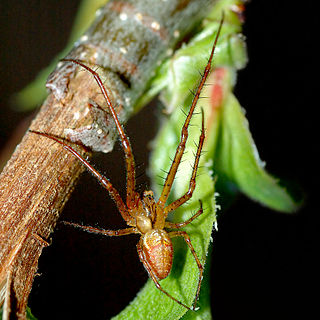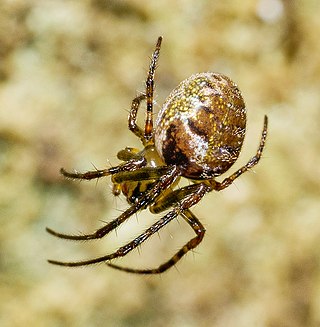
Long-jawed orb weavers or long jawed spiders (Tetragnathidae) are a family of araneomorph spiders first described by Anton Menge in 1866. They have elongated bodies, legs, and chelicerae, and build small orb webs with an open hub with few, wide-set radii and spirals with no signal line or retreat. Some species are often found in long vegetation near water.

Leucauge is a spider genus of long-jawed orb weavers, with over 160 species and fully pantropical distribution.

Dolichognatha is a genus of tropical and subtropical long-jawed orb-weavers that was first described by Octavius Pickard-Cambridge in 1869. Originally placed with the Archaeidae, it was transferred to the Araneidae in 1967, and to the Tetragnathidae in 1981.

Taraire is a small genus of Polynesian long-jawed orb-weavers. The genus was first described by A. Álvarez-Padilla, R. J. Kallal and Gustavo Hormiga in 2020, and it has only been found in New Zealand. They build vertical orb webs near forest floors, and can be found resting in the center. The genus name is a reference to Beilschmiedia tarairi, the native New Zealand tree that they are commonly found in.
Pinkfloydia is a genus of small Australian long-jawed orb-weavers, reaching a maximum lengths of about 4.5 millimetres (0.18 in). It was first described by D. Dimitrov & G. Hormiga in 2011, and contains two species, found in New South Wales and Western Australia: P. harveyi and P. rixi. They have a unique rounded, cone-shaped head structure with one pair of large eyes and three pairs of smaller eyes. The genus is named after British rock band Pink Floyd.
Dolichognatha junlitjri is a species of orb-weaver spiders found in the Philippines. The species was discovered in Molawin Creek at Mount Makiling, and was described, illustrated and named by Aimee Lynn Barrion-Dupo and Alberto T. Barrion who published their discovery in 2014. They considered that the genus Prolochus, treated a synonym of Dolichognatha by sources such as the World Spider Catalog as of January 2021, should be revived. It would include Dolichognatha longiceps as Prolochus longiceps, and Prolochus junlitjri. However, a molecular phylogenetic study in 2018 did not support this, and placed the species in Dolichognatha, the placement accepted by the World Spider Catalog.
Schenkeliella is a monotypic genus of Sri Lankan long-jawed orb-weavers containing the single species, Schenkeliella spinosa. The species was first described by Octavius Pickard-Cambridge in 1871 under the name Oeta spinosa, but it was renamed to "Schenkeliella" by Embrik Strand in 1934 because the name was already in use for a genus of ermine moths. Originally placed with the Nesticidae, it transferred to the Tetragnathidae in 1980.

Tylorida is a genus of long-jawed orb-weavers that was first described by Eugène Louis Simon in 1894.
Chrysometa is a genus of long-jawed orb-weavers that was first described by Eugène Louis Simon in 1894. It is a senior synonym of Capichameta.

Nanometa is a genus of long-jawed orb-weavers containing the fifteen species. It was erected by Eugène Louis Simon based on the type specimen of Nanometa gentilis found in 1908. It is included in a clade of its own defined by nine morphological synapomorphies, along with the genus Orsinome.

Orsinome is a genus of long-jawed orb-weavers that was first described by Tamerlan Thorell in 1890. It is included in the Nanometa clade, defined by nine morphological synapomorphies, along with Eryciniolia and Nanometa.
Epeirotypus is a genus of ray spiders that was first described by Octavius Pickard-Cambridge in 1894.
Sancus is a genus of long-jawed orb-weavers that was first described by Hugo Albert Tullgren in 1910. As of November 2019 it contains two species, found in Tanzania, Kenya, and on the Azores: S. acoreensis and S. bilineatus. The name "Sancus" is currently accepted by the World Spider Catalog, but it was already in use for a genus of skippers when this genus was named.
Allende is a genus of South American long-jawed orb-weavers that was first described by F. Álvarez-Padilla in 2007.
Metabus is a genus of long-jawed orb-weavers that was first described by Octavius Pickard-Cambridge in 1899.
Harlanethis is a small genus of Australian long-jawed orb-weavers. It was first described by A. Álvarez-Padilla, R. J. Kallal and Gustavo Hormiga in 2020, and it has only been found in Australia. As of April 2022 it contains only two species: H. lipscombae and H. weintrauborum.
Iamarra is a monotypic genus of Australian long-jawed orb-weavers containing the single species, Iamarra multitheca. It was first described by A. Álvarez-Padilla, R. J. Kallal and Gustavo Hormiga in 2020, and it has only been found in Australia.

Tawhai is a monotypic genus of Polynesian long-jawed orb-weavers containing the single species Tawhai arborea. The genus was first described by A. Álvarez-Padilla, R. J. Kallal and Gustavo Hormiga in 2020, and it has only been found in New Zealand. The type species, Tawhai arborea, was originally described under the name "Tetragnatha arborea".
Diphya wesolowskae is a species of long-jawed orb weaver in the genus Diphya that lives in South Africa. First described in 2020 by Mikhail Omelko, Yuri Marusik and Robin Lyle, the spider is small, with a typical length between 2.8 and 3.17 mm. The female is larger than the male. It has a brown to dark brown and patternless carapace, which distinguishes the species from the more common Diphya simoni. The male has an abdomen that is also brown to dark brown and has a pattern of two dark spots, although some examples have more complex, but indistinct, patterns of spots and stripes. The female has a light brown abdomen marked with large spots and stripes. The copulatory organs are distinctive to the species. The female has a epigyne that lacks pockets but has a thicker septal stem than Diphya foordi, and the male has a very long, thin projection that extends from the palpal bulb beyond the cymbium and a very short embolus.







